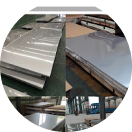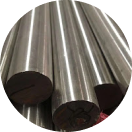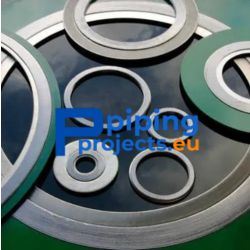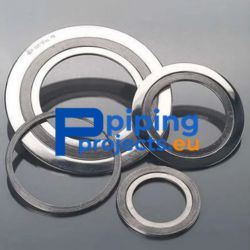PipingProjects.eu is one of the leading Gaskets Manufacturer in Europe. Our dedication to quality assurance ensures your satisfaction and trust in our products, making us your preferred partner for reliable gasket solutions. As a trusted Gasket Supplier in Europe, our commitment to excellence shines through our unwavering compliance with industry norms. Our offerings boast outstanding sealing capabilities and impeccable resilience against extreme temperatures and corrosive environments.
A Gasket is a pliable elastomeric material that is fashioned into a ring or sheet shape. Its primary function is to fill the gap between two or more mating surfaces, thereby preventing leakage when two objects are joined under compression. Gaskets and seals are typically constructed from a variety of materials, including rubber, metal, cork, neoprene, carbon fiber, glass, cellulose, silicon, and other fibrous materials. These materials are chosen for their unique properties and ability to withstand varying temperatures and pressures. Non-metallic gaskets are also available, which can reduce distortion while accommodating thermal expansion and contraction. Gaskets seal a connection between two components or flanges that have flat surfaces, while seals are used between engine parts, pumps, and shafts that rotate. Gaskets are used wherever a union or flange is required to prevent leaking. Gaskets are most commonly used as static seals.
As a leading Gaskets Manufacturer in Europe, a gasket is a specialized seal that is fabricated to fit between two or more surfaces, such as two lengths of piping. Its primary function is to prevent leakage while being subjected to varying levels of compression. In industries such as oil rigs and refineries, gaskets are extensively utilized to withstand high compressive loads without allowing the oils and gases carried by the pipes to escape. The importance of gaskets in these industries cannot be overstated, as they play a crucial role in ensuring the safety and efficiency of operations.

Does this product seem useful to you?
Reach out to us now for quick support.
Trusted
Supplier
Genuine
Product
Easy
purchase
Gaskets Specification Chart
| Particulars | Specification | |
|---|---|---|
| Gasket Sizes | 1/2 NB – 24 NB | |
| Outside Diameter | NPS 1⁄2 through NPS 8 is ±0.4 mm; for NPS 10 through NPS 24, ±0.8 mm. | |
| Inside Diameter | NPS 1⁄2 through NPS 8 is ±0.4 mm; for NPS 10 through NPS 24, ±0.8 mm. | |
| Thickness | 1mm, 1.5mm, 2mm, 3mm | |
| Temperature range | -20°C to 120°C | |
| Finish | Bright / Matt / Dull | |
| Grade | ||
| Stainless Steel | 200 Series - 201, 202, 205.
300 Series 301, 302, 303, 304, 304L, 308, 309, 309S, 310, 310S, 314, 316, 316L, 316TI, 317, 317L, 321, 347. 400 Series 405, 409, 429, 430, 430F, 430FSe, 434, 436, 442, 446, 403, 410, 414,416, 416Se, 420,420F, 422, 431, 440A, 440B, 440C. 500 Series - 501, 502. 600 Series - 630 (17-4 PH). |
|
| Carbon Steel | ASTM A106 Gr. A , B & C API 5L Gr. A / B, X42 ,X52 ,X60 ASTM A 53 Gr. A/B | |
| Titanium | Titanium 6-4, Gr 1, Gr 2, Gr 3, Gr 4, Gr 5, Gr 7, Gr 9, 5-2.5, 6-2-4-2, 6-4 ELI, 6-6-2. | |
| Hastelloy | C22, C276, X, B-2. | |
| Monel | 400, K500. | |
| Nickel Alloy | Nickel 200 Nickel 201, Alloy 20, Alloy 286, Alloy 218 (Nitronic 60), Nitronic 50 (XM-19). | |
| Cupro Nickel | Cu 90-10 (C70600,CW352H), Cu 70-30 (C71500, CW354H). | |
| Inconel | 601, 625, 660A, 718, X-750, 825, 925, 608. | |
| Duplex / Super Duplex | D S31803, D S32205, SD S32750, SD S32760, SD S32950. | |
| Chromium Molybdenum Steel | A387 Gr 2, A387 Gr 12, A387 Gr 11, A387 Gr 22, A387 Gr 22L, A387 Gr 7, A387 Gr 21, A387 Gr 21L, A387 Gr 9, A387 Gr 91. | |
| Nichrome Alloy | CrNi 20/80. | |
| Copper | ASTM B1, ASTM B2, ASTM B3, ASTM B152, ASTM B124, ASTM B133. | |
| Brass | Alloy 260, Alloy 272, Alloy 330, Alloy 353, Alloy 360, Alloy C48200 - C48500, Alloy 464. | |
| Bronze | Alloy 954, Alloy 933. | |
| Case Hardening Steels | 10C4, 15C8, 15Cr3, 16Mn5Cr4, 20MnCr5, 15Ni5Cr4Mo1, 15Ni5Cr4Mo2, 20Ni7Mo2, 20NiCrMo2, 14CrNi6. | |
| En Series | En8, En9, En19, En24, En30B, En31, En36, En45, En47, En48. | |
| Mild Steel | Sae 4118, Sae 4120, Sae 4120, Sae 4130, Sae 4135, Sae 4137, Sae 4140, Sae 4142, Sae 4145, Sae 4147, Sae 4150, Sae 4161, Sae 8620. | |
What Makes Us the Premier Manufacturer and Supplier of Gaskets in Europe?
PipingProjects.eu is a top Gaskets Manufacturer in Europe. We adhere to rigorous quality control protocols and standards to ensure superior surface and dimensional tolerances in the production of Gasket. Our company is a prominent provider of carbon steel, alloy steel, and Gasket solutions worldwide, boasting ASME Quality and ISO Certifications. In addition to manufacturing top-tier Gasket, we are authorized dealers of ISMT and Jindal for the distribution of carbon steel and alloy steel Gasket. We are also a top Gaskets Supplier in Europe.
Ring Gaskets Size Chart
| Nominal Pipe Size | Gasket I.D. (Inches) |
Gasket O.D. (Inches) |
|---|---|---|
| 1/2 | 27/32 | 1 7/8 |
| 3/4 | 1 1/16 | 2 1/4 |
| 1 | 1 5/16 | 2 5/8 |
| 1 1/4 | 1 21/32 | 3 |
| 1 1/2 | 1 29/32 | 3 3/8 |
| 2 | 2 3/8 | 4 1/8 |
| 2 1/2 | 2 7/8 | 4 7/8 |
| 3 | 3 1/2 | 5 3/8 |
| 3 1/2 | 4 | 6 3/8 |
| 4 | 4 1/2 | 6 7/8 |
| 4 1/2 | 5 | 7 |
| 5 | 5 9/16 | 7 3/4 |
| 6 | 6 5/8 | 8 3/4 |
| 7 | 7 5/8 | 10 |
| 8 | 8 5/8 | 11 |
| 10 | 10 3/4 | 13 3/8 |
| 12 | 12 3/4 | 16 1/8 |
| 14 | 14 | 17 3/4 |
| 15 | 15 | 19 |
| 16 | 16 | 20 1/4 |
| 18 | 18 | 21 5/8 |
| 20 | 20 | 23 7/8 |
| 22 | 22 | 26 |
| 24 | 24 | 28 1/4 |
| 26 | 26 | 30 1/2 |
| 28 | 28 | 32 3/4 |
| 30 | 30 | 34 3/4 |
| 32 | 32 | 37 |
| 34 | 34 | 39 |
| 36 | 36 | 41 1/4 |
| 38 | 38 | 43 5/8 |
| 40 | 40 | 45 5/8 |
| 42 | 42 | 48 |
| 46 | 46 | 52 1/8 |
| 48 | 48 | 54 1/2 |
| 50 | 50 | 56 1/2 |
| 52 | 52 | 58 3/4 |
| 54 | 54 | 61 |
| 60 | 60 | 67 1/2 |
| 66 | 66 | 74 1/4 |
| 72 | 72 | 80 3/4 |
| 84 | 84 | 93 1/2 |
| 96 | 96 | 106 1/4 |
What is Flat Ring Gasket?
A Flat Ring Gasket is a mechanical seal utilized for sealing purposes across diverse industries. It typically assumes a circular or ring-shaped configuration with a flat profile, in contrast to other gasket types such as spiral wound or serrated gaskets that exhibit more intricate designs. The materials used in the manufacture of flat ring gaskets commonly include rubber, silicone, neoprene, PTFE (Teflon), cork, or various types of metals, contingent on the specific application and the prerequisites for sealing effectiveness and durability.
PipingProjects.eu is a leading Gaskets Supplier in Europe. These are a few examples of Gaskets you can find at Piping Projects in Europe.
Dimension Of Flat Ring Gaskets
| Nominal Pipe Size | Inside Diameter (mm) |
Outside Diameter (mm) |
||||
|---|---|---|---|---|---|---|
| DN | INCH | Class 150 | Class 300 | Class 400 | Class 600 | |
| 650 | 26 | 660 | 775 | 835 | 832 | 867 |
| 700 | 28 | 711 | 832 | 899 | 892 | 914 |
| 750 | 30 | 762 | 883 | 953 | 946 | 972 |
| 800 | 32 | 813 | 940 | 1006 | 1003 | 1022 |
| 850 | 34 | 864 | 991 | 1057 | 1054 | 1073 |
| 900 | 36 | 914 | 1048 | 1118 | 1118 | 1130 |
| 950 | 38 | 965 | 1111 | 1054 | 1073 | 1105 |
| 1000 | 40 | 1016 | 1162 | 1114 | 1127 | 1156 |
| 1050 | 42 | 1067 | 1219 | 1165 | 1178 | 1219 |
| 1100 | 44 | 1118 | 1276 | 1219 | 1232 | 1270 |
| 1150 | 46 | 1168 | 1327 | 1273 | 1289 | 1327 |
| 1200 | 48 | 1219 | 1384 | 1324 | 1346 | 1391 |
| 1250 | 50 | 1270 | 1435 | 1378 | 1403 | 1448 |
| 1300 | 52 | 1321 | 1492 | 1429 | 1454 | 1499 |
| 1350 | 54 | 1372 | 1549 | 1492 | 1518 | 1556 |
| 1400 | 56 | 1422 | 1607 | 1543 | 1568 | 1613 |
| 1450 | 58 | 1473 | 1664 | 1594 | 1619 | 1664 |
| 1500 | 60 | 1524 | 1715 | 1645 | 1683 | 1721 |
Dimension Of Flat Ring Gaskets Up To 24 Inches
| Nominal Pipe Size | Inside Diameter (mm) |
Outside Diameter (mm) |
|||||
|---|---|---|---|---|---|---|---|
| DN | Inch | Class 150 | Class 300 | Class 400 | Class 600 | Class 900 | |
| 15 | 1/2 | 21 | 48 | 54 | 54 | 54 | 64 |
| 20 | 3/4 | 27 | 57 | 67 | 67 | 67 | 70 |
| 25 | 1 | 33 | 67 | 73 | 73 | 73 | 79 |
| 32 | 1-1/4 | 42 | 76 | 83 | 83 | 83 | 89 |
| 40 | 1-1/2 | 48 | 86 | 95 | 95 | 95 | 98 |
| 50 | 2 | 60 | 105 | 111 | 111 | 111 | 143 |
| 65 | 2-1/2 | 73 | 124 | 130 | 130 | 130 | 165 |
| 80 | 3 | 89 | 137 | 149 | 149 | 149 | 168 |
| 90 | 3-1/2 | 102 | 162 | 165 | 162 | 162 | – |
| 100 | 4 | 114 | 175 | 181 | 178 | 194 | 206 |
| 125 | 5 | 141 | 197 | 216 | 213 | 241 | 248 |
| 150 | 6 | 168 | 222 | 251 | 248 | 267 | 289 |
| 200 | 8 | 219 | 279 | 308 | 305 | 321 | 359 |
| 250 | 10 | 273 | 340 | 362 | 359 | 400 | 435 |
| 300 | 12 | 324 | 410 | 422 | 419 | 457 | 498 |
| 350 | 14 | 356 | 451 | 486 | 483 | 492 | 521 |
| 400 | 16 | 406 | 514 | 540 | 537 | 565 | 575 |
| 450 | 18 | 457 | 549 | 597 | 594 | 613 | 638 |
| 500 | 20 | 508 | 606 | 654 | 648 | 683 | 699 |
| 600 | 24 | 610 | 718 | 775 | 768 | 791 | 838 |
What Measures can be Taken to Prevent Rusting of Gaskets?
To prevent gasket corrosion, take proactive efforts to protect them from moisture and corrosive substances. One viable technique is to use gaskets composed of corrosion-resistant materials like stainless steel, graphite, or rubber with suitable coatings. Stainless steel gaskets, for example, are highly resistant to rust and corrosion, making them perfect for harsh situations.
Furthermore, using protective coatings or sealants designed to discourage rust formation can extend the life of gaskets, especially in situations where moisture or corrosive chemicals are unavoidable. Regular inspection and maintenance procedures should also be developed to detect and resolve any symptoms of corrosion early on, preventing serious damage and ensuring that the gaskets continue to function properly.
Applications Of Gaskets






Gaskets Manufacturer in Europe

Gaskets Supplier in Europe
